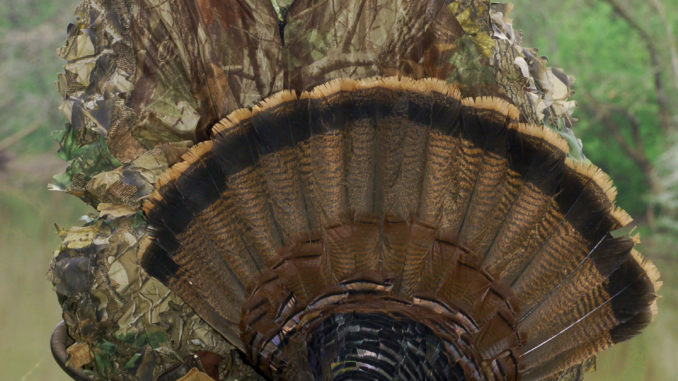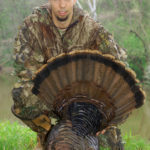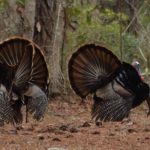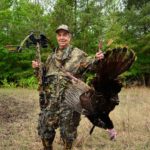
The birds change, and so should North Carolina hunters and their tactics as the end of turkey season approaches.
Spring turkey season arrived for North Carolina hunters a couple of weeks ago, so it’s been long enough for the drive to tag a longbeard to falter when normal tactics didn’t produce. But instead of hanging up their camouflage and trading their calls for a fishing rod or golf club, the last two weeks of the season can be the best time to lure a gobbler into range and should never be avoided for a true feathered fanatic.
The opening of the season can be very exciting, especially after months of preparation and with plenty of toms gobbling frequently. Many hunters believe the end of the season is one of the toughest times to take down a gobbler. In some instances, that might be true. Statistically, there are fewer turkeys available to hunt and the remaining birds have learned some of the hunter’s tricks.
Zac Morton of Advance, a veteran hunter who is a regional director for the National Wild Turkey Federation, said tactics in the late season may be significantly different, but is directly related to hunting pressure of a specific flock.
“As turkey hunters, we like to make them gobble as much as possible, but it is our downfall in the end,” he said. “Most turkey hunters, me included, will overcall frequently; that educates the flock within hearing distance and makes it harder to get these birds to come in later.”
An educated turkey is always tougher to bring into range than a neophyte gobbler with virgin ears roaming the woods all by his lonesome. But even an educated gobbler can be called into range without too much difficulty if the correct strategy is employed — even late in the season.
From years of experience hunting in the eastern part of the state, Morton recommends hunters utilize different types of call to find that one that an apprehensive tom hasn’t heard.
“Every turkey is different,” he said. “Sometimes a turkey will gobble at a slate call better over a box call, wing-bone call or a diaphragm call — and vice-versa.
“Always have several options in your turkey hunting vest. The more tools you have in your toolbox, the better off you will be to get that turkey to come into range.”
Decoys can be deadly, but educated gobblers can also get a bad taste in their mouths from a decoy, especially in areas with open fields regularly hunted with decoys.
“If the birds have had a lot of pressure — if they have been on the decoy all year long — keep the decoys in the bag,” Morton said.
Often, young gobblers will travel together early in the season in groups of four to five, birds that are typically from the same hatch. If one in the group gets shot, the remaining birds will become skittish of similar calling, and decoys used, or the place where their running buddy got killed. The surviving flock learns from the forced lesson from the guy in leafy camo to avoid similar situations.
On the flip side and from a biological standpoint, turkeys may be more likely to respond to the cries and yelps of a hen call towards the end of the season, as long as hunting stress doesn’t outweigh biological pressures.
Evin Stanford, the biologist who supervises wild-turkey management for the N.C. Wildlife Resources Commission, said the first part of the season may be a tough time to get a turkey to come in. Gobblers may respond better to calling later in the season.
“From a biological standpoint, gobblers are congregated around the hens in the early season and are breeding heavily. They can be tough to call off their mates,” Stanford said.
Gobblers may readily gobble back at hunters; these birds are fired up and want to breed everything they can find, but few will be interested in leaving their girls alone with many other gobblers in the areas ready to sneak in and breed their hens.
“As the season progresses, the hens will start setting, and the lone gobblers will leave their hens on the prowl for any available mates,” Stanford said.
Even though fewer gobblers are available late in the season, they can be much easier to harvest.
“Gobblers are more susceptible to harvest when most hens are setting. It is often less frustrating, and the birds are much easier to call in and with less effort,” he said.
But turkeys are still highly educated late in the season, and hunters must exercise caution with their calls. A less-aggressive calling style will be much better received by the few gobblers in the area, because everything is talking less as May approaches. Not only will gobblers respond less vocally in the late season, hens will also call much less. In order for turkey hunters to be successful, their calling style must emulate the natural order.
Morton hunts until the very last day of most seasons, and he believes he can fill his last tag with the most-important virtue every turkey hunter should have.
“You must be patient while turkey hunting and it is extremely important in the late season,” he said. “If you hear one or two gobbles from a bird in early May, that’s about all you are going to get. But the bird will usually still come in; you just will not hear him gobbling his way to you like he would on April 15.”
Additionally, successful late season hunters will rely less on calling and will find areas to set up in places where they can intercept the birds. Look for places with a high concentration of sign, including fresh tracks and scratching and dusting areas in places where birds feed and roost.
Turkeys will often shift to different food sources in the later part of the season as well. When the season begins in early April, the trees have very few leaves and most agricultural fields haven’t been planted. As the season progresses, the fields are full of small tender crops, and the woodlands are covered in fresh, lush greenery. Turkeys are somewhat nomadic and will migrate locally to take advantage of rich foods — but always near good roosting cover. As soon as turkeys find something they like, expect them to stay in these areas as long as they can.
According to Stanford, turkeys are creatures of habitat just like deer and will follow a routine schedule.
“There are variations in what they do, but they will frequent the same habitats on a daily basis when the food is available,” he said. “Turkeys utilize the areas where the food and cover is available. Later in the season, as things green up and the crops change, it will affect their movements.”
Stanford expects gobblers to move towards open areas along roadsides, food plots and agriculture fields to both find something to eat and hopefully encounter an available hen.
Fallow fields overgrown in weeds and grasses or power-line right-of -ways are good places to look for late-season activity. They know that hens will be close by, and the high grass gives them a sense of security.







Be the first to comment